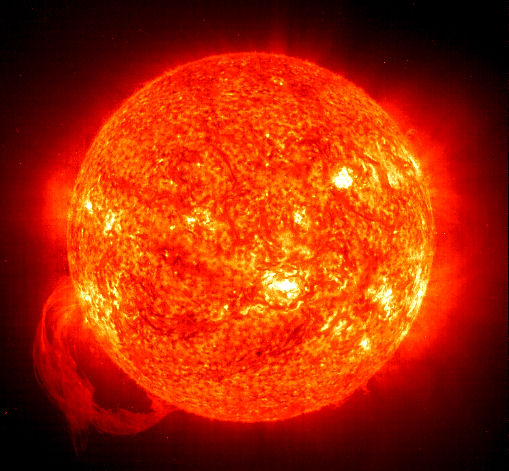What Is The Combined Percentage Of Hydrogen And Helium In The Sun's Makeup Of Gases? * 1 Point
The Sun and Nuclear Fusion
"The Lord's day, with all the planets revolving around it, and depending on it, can still ripen a bunch of grapes equally though it had nothing else in the Universe to do." ~ Galileo

Mass: 1.989x1030 kg
Radius: 695,000 km (equator)
Mean Density: one.410 gm/cmthree
Rotation Flow: 25 - 36 days
Escape Velocity: 618.02 km/sec
Luminosity: 3.839 10 ten26 watts
Magnitude (Vo): -26.8
Surface Temp: v,780 One thousand (mean)
Historic period: 4.v billion years
In the cadre of the Sunday hydrogen is existence converted into helium. This is called nuclear fusion. It takes iv hydrogen atoms to fuse into each helium atom. During the process some of the mass is converted into energy.
Mass of four H atoms: 4.03130 AMU
Mass of ane He atom: 4.00268 AMU
1 Atomic Mass Unit (AMU) equals 1.67x10-27kgs
The difference between the mass of 4 H atoms and 1 He atom is 0.02862 AMU which is merely 0.71% of the original mass. This small fraction of the mass is converted into free energy. If four grams (1/8 ounce) of H are converted to He, only two.8x10-3 grams of the mass is converted to energy:
How much energy is generated from converting such a tiny amount of mass? We can summate by using Einstein's famous formula.
Eastward = mctwo
Due east = (ii.8x10-iii grams) 10 c2
E = (2.8x10-6 kgs) 10 (3x1081000/sec)two
E = 2.6x10eleven joules
Enough energy to keep a 60-watt lite bulb shining for over 100 years!
The Dominicus has different layers with different backdrop, these layers are composed of material that is nearly 75% hydrogen and 25% helium by mass. Simply put, the Sun is a nifty ball of gas, hot enough to glow in every tier. In the very innermost part of the Sun, chosen its core, the temperature is about xv meg Kelvins, the density is 150 times that of water, and the force per unit area is over 200 billion times greater than atmospheric pressure here on Globe. This heavy, sweltering place is where the Sun's energy is produced via a process known as thermonuclear fusion.
While fusion is difficult to mimic on Earth, the core of the Dominicus and other stars is a perfect environment for it. Here, the temperatures are high enough for hydrogen nuclei to smash together and grade helium nuclei, releasing tremendous amounts of energy in various forms. Energy produced in the form of light keeps bouncing around inside the Sun, every bit though the Sun were made entirely of mirrors. A particle of low-cal can take more than thirty,000 years to reach the surface and escape! Energy in the form of small particles called neutrinos, yet, can travel directly out of the Sun and into the Solar System. Neutrino observatories on Globe measure the continual wash of these tiny, fast-moving particles.
The credible visual magnitude of the Sun is -26.8, making information technology announced about 10 billion (x,000,000,000) times equally bright as the adjacent brightest star, Sirius. The accented magnitude of the Sunday, the magnitude it would have at a distance of 10 parsec or 32.6 light years, is +four.viii. Among the brightest stars we tin see with the naked eye, there is only ane, blastoff Centauri, with a comparable absolute magnitude to the Sunday. Virtually of the rest are intrinsically far brighter.
Light takes well-nigh 500 seconds (8 1/3 minutes) to travel from the Sunday to the Earth.
The average distance to the Globe from the center of the Sun is about 149,000,000 km, or 93,000,000 miles; a distance known as an astronomical unit (AU). There are over 63,000 AU in one light year. i AU is about 0.000016 calorie-free year. The nearest star, alpha Centauri, is four.three low-cal years afar, or well-nigh 280,000 AU.

Activity on the solar surface, photo by Brad Snowder.
Source: https://www.wwu.edu/astro101/a101_sun.shtml
Posted by: fultzbuts1992.blogspot.com

0 Response to "What Is The Combined Percentage Of Hydrogen And Helium In The Sun's Makeup Of Gases? * 1 Point"
Post a Comment